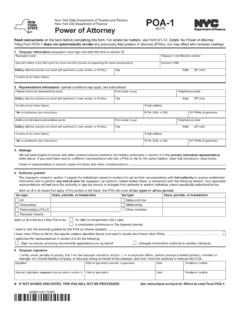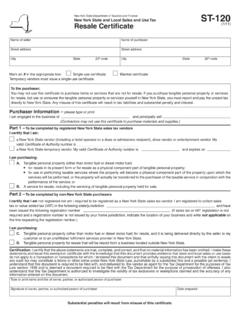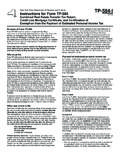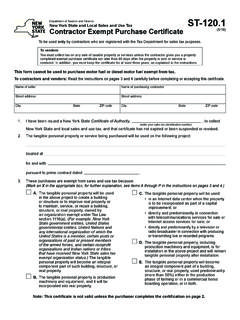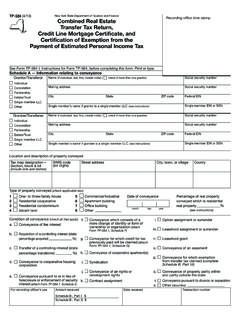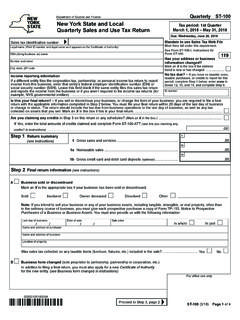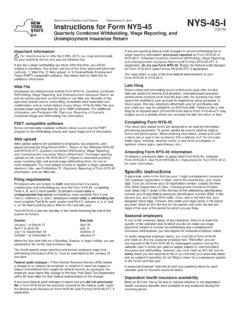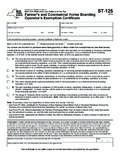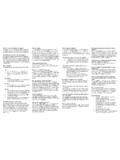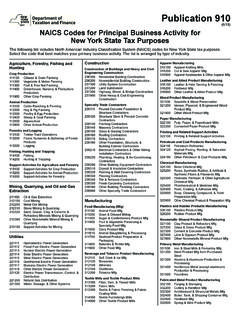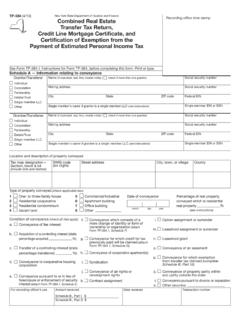Transcription of New York State Department of Taxation and Finance …
1 new york State Department of Taxation and Finance Office of Tax Policy Analysis TSB-M-02(9)I. Income Tax Technical Services Division October 17, 2002. new york Tax Treatment of Distributions and Rollovers Relating to Government IRC Section 457 Deferred Compensation Plans Recent federal legislation has amended Internal Revenue Code (IRC) sections 457 and 3401. to change the characterization of distributions from government section 457 deferred compensation plans. The legislation does not affect the characterization of distributions from the plans of any other exempt organizations. These changes apply to tax years beginning on or after January 1, 2002.
2 The new law provides that distributions from these plans will be characterized as pension or annuity payments. Under prior law, these distributions were characterized as wages. In addition, the new law allows for tax-free transfers, via a trustee-to-trustee transfer, between government section 457. deferred compensation plans and other qualified retirement plans and traditional individual retirement accounts (IRAs). These changes affect the new york tax treatment of distributions from government section 457 plans, effective for tax years beginning on or after January 1, 2002, as described below. Distributions from the section 457 deferred compensation plans of any other tax exempt organization will be addressed in Publication 36, General Information for Senior Citizens and Retired Persons For tax year 2002.
3 When this publication is released, it will be made available on the Tax Department 's web site at Pension and Annuity Exclusion new york State , city of new york and city of Yonkers resident individuals, estates, and trusts Distributions from government section 457 plans are includible in federal adjusted gross income and therefore are includible in new york adjusted gross income. However, under section 612(c)(3-a) of the new york Tax Law, an individual who has reached the age of 59 may exclude up to $20,000 of certain pension and annuity income included in his or her federal adjusted gross income when computing his or her new york adjusted gross income.
4 Effective for tax years beginning on or after January 1, 2002, distributions from government section 457 deferred compensation plans will qualify for this exclusion, provided the individual is age 59 or older at the time the distribution was received, and the distributions from the plan are being made in periodic payments. Periodic payments are a series of payments made over a period of more than one year. If an individual, estate or trust received pension and annuity income of a decedent, they may also qualify for the up to $20,000 exclusion if the decedent would have been entitled to it, had the decedent continued to live, regardless of the age of the beneficiary.
5 Important Note: Under the new federal rules, participants in a government section 457 plan may make a tax-free rollover of their section 457 plan funds into an IRA (see Rollovers to and from Section 457 Plans on page 5). Taxpayers who wish to withdraw their government section 457 plan funds in a lump-sum or in a series of payments made within one year should note that distributions W A Harriman Campus, Albany NY 12227 -2- TSB-M-02(9)I. Income Tax October 17, 2002. from an IRA qualify for the $20,000 exclusion even if the payments are not periodic. Accordingly, these taxpayers may wish to first roll-over their government section 457 plan funds into an IRA, thus making them eligible for the exclusion when they withdraw the funds from the IRA (provided they are age 59 or older at the time of the withdrawal).
6 new york State nonresident individuals Section 601(e) of the new york State Tax Law imposes a personal income tax on a nonresident individual's taxable income that is derived from new york sources. The tax is equal to the tax computed as if the individual were a new york State resident for the entire year, reduced by certain credits, multiplied by the income percentage. The numerator of the fraction used to compute the income percentage is the individual's new york source income. The new york source income of a nonresident is the sum of the items of income, gain, loss, and deduction entering into federal adjusted gross income derived from or connected with new york sources and any new york additions and subtraction modifications under section 612(b) and 612(c) of the Tax Law that relate to adjusted gross income derived from new york sources.
7 The denominator of the fraction used to compute the income percentage is the nonresident's new york adjusted gross income from all sources for the entire year. Distributions from a government section 457 plan are included in computing the individual's new york State tax as if a resident and the individual's new york adjusted gross income (the denominator of the income percentage). Therefore, the up to $20,000 pension and annuity exclusion that is allowed to a new york State resident is allowed to a nonresident when computing the nonresident's new york adjusted gross income from all sources for the entire year (the denominator of the income percentage) and the new york State tax as if a resident for the entire year.
8 Section 114 of Title 4 of the United states Code, effective for tax years beginning after 1995, created a limitation on State income Taxation of certain pension income and income from section 457. deferred compensation plans. Under this federal law, distributions from a section 457 deferred compensation plan do not constitute income derived from new york State sources and are not included in new york source income (the numerator of the income percentage). Accordingly, nonresident taxpayers may not claim the up to $20,000 pension and annuity exclusion in computing their new york source income. new york State nonresident estates and trusts A nonresident estate or trust computes its new york State personal income tax in the same manner as a nonresident individual.
9 Accordingly, the above rules applicable to nonresident individuals also apply to a nonresident estate or trust in computing the new york source income, new york adjusted gross income, and new york State tax as if a resident for the entire year. -3- TSB-M-02(9)I. Income Tax October 17, 2002. Yonkers nonresident individuals, estates, or trusts Yonkers nonresidents who are full-year new york State residents Generally, a Yonkers nonresident individual, estate, or trust is subject to the Yonkers nonresident earnings tax on wages earned or net earnings from self-employment within that city. For tax years beginning on or after January 1, 2002, distributions from a government section 457 deferred compensation plan received by a Yonkers nonresident who is a new york State resident, do not constitute wages or net earnings from self- employment derived from Yonkers sources and, therefore, are not subject to the nonresident earnings tax.
10 Yonkers nonresidents who are full-year new york State nonresidents In the case of a Yonkers nonresident who is a new york State nonresident, distributions received from a government section 457 plan received in tax years beginning after 1995. are exempt from the Yonkers nonresident earnings tax pursuant to section 114 of Title 4 of the United states Code. new york State part-year resident individuals A new york State part-year resident individual computes his or her new york State personal income tax in the same manner as a nonresident individual. However, the new york source income of a part-year resident (the numerator of the income percentage) is the sum of the following: (1) the individual's new york adjusted gross income from all sources for the resident period, determined as if the individual's tax year for federal income tax purposes were limited to the resident period.
